汉服中英文对照
- 格式:docx
- 大小:13.42 KB
- 文档页数:1
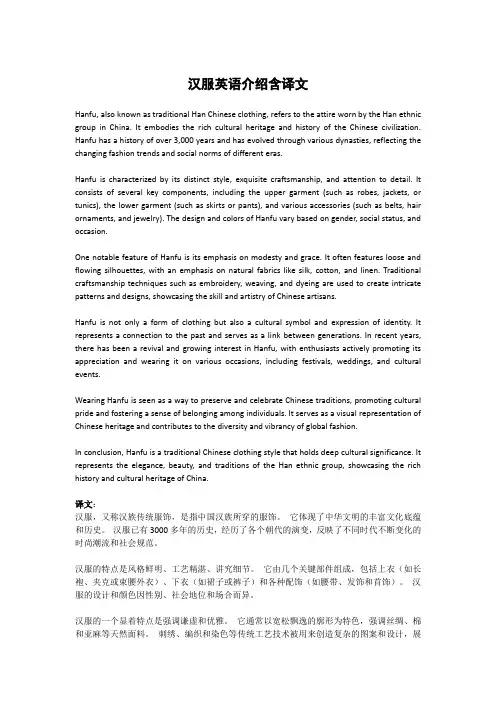
汉服英语介绍含译文Hanfu, also known as traditional Han Chinese clothing, refers to the attire worn by the Han ethnic group in China. It embodies the rich cultural heritage and history of the Chinese civilization. Hanfu has a history of over 3,000 years and has evolved through various dynasties, reflecting the changing fashion trends and social norms of different eras.Hanfu is characterized by its distinct style, exquisite craftsmanship, and attention to detail. It consists of several key components, including the upper garment (such as robes, jackets, or tunics), the lower garment (such as skirts or pants), and various accessories (such as belts, hair ornaments, and jewelry). The design and colors of Hanfu vary based on gender, social status, and occasion.One notable feature of Hanfu is its emphasis on modesty and grace. It often features loose and flowing silhouettes, with an emphasis on natural fabrics like silk, cotton, and linen. Traditional craftsmanship techniques such as embroidery, weaving, and dyeing are used to create intricate patterns and designs, showcasing the skill and artistry of Chinese artisans.Hanfu is not only a form of clothing but also a cultural symbol and expression of identity. It represents a connection to the past and serves as a link between generations. In recent years, there has been a revival and growing interest in Hanfu, with enthusiasts actively promoting its appreciation and wearing it on various occasions, including festivals, weddings, and cultural events.Wearing Hanfu is seen as a way to preserve and celebrate Chinese traditions, promoting cultural pride and fostering a sense of belonging among individuals. It serves as a visual representation of Chinese heritage and contributes to the diversity and vibrancy of global fashion.In conclusion, Hanfu is a traditional Chinese clothing style that holds deep cultural significance. It represents the elegance, beauty, and traditions of the Han ethnic group, showcasing the rich history and cultural heritage of China.译文:汉服,又称汉族传统服饰,是指中国汉族所穿的服饰。
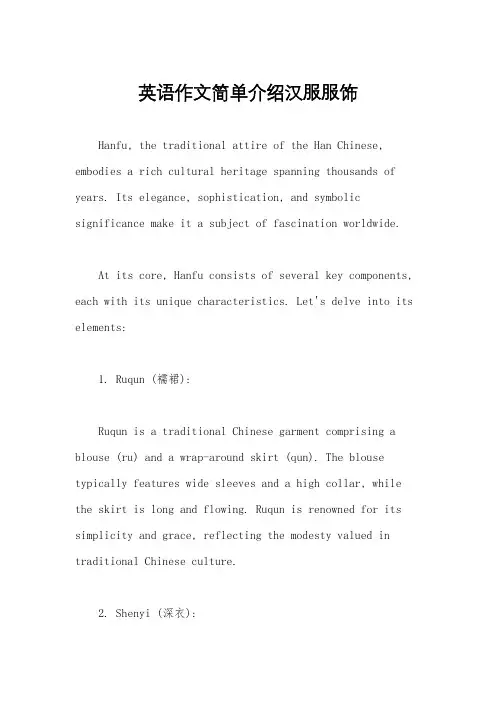
英语作文简单介绍汉服服饰Hanfu, the traditional attire of the Han Chinese, embodies a rich cultural heritage spanning thousands of years. Its elegance, sophistication, and symbolic significance make it a subject of fascination worldwide.At its core, Hanfu consists of several key components, each with its unique characteristics. Let's delve into its elements:1. Ruqun (襦裙):Ruqun is a traditional Chinese garment comprising a blouse (ru) and a wrap-around skirt (qun). The blouse typically features wide sleeves and a high collar, while the skirt is long and flowing. Ruqun is renowned for its simplicity and grace, reflecting the modesty valued in traditional Chinese culture.2. Shenyi (深衣):Shenyi is an ancient form of Han Chinese clothing that originated in the Shang Dynasty (c. 1600–1046 BCE). It consists of a cross-collar robe (yi) worn over a pleated skirt. Shenyi symbolizes the hierarchical structure of ancient Chinese society, with different variations worn by individuals of various social statuses.3. Zhongshan Zhuang (中山装):Zhongshan Zhuang, also known as the Zhongshan suit, is a modern adaptation of traditional Chinese attire. It features a high-collared, long-sleeved jacket paired with trousers, reflecting the influence of Western fashion during the early 20th century. Zhongshan Zhuang is often worn on formal occasions and has become a symbol of Chinese national identity.4. Quju (曲裾):Quju is a style of Han Chinese clothing characterized by its asymmetrical hemline, which forms a flowing curveknown as "water sleeve." This design element adds a senseof movement and dynamism to the garment, making it particularly suitable for ceremonial occasions such as weddings and festivals.5. Pibo (披帛):Pibo refers to the outer garments worn over the primary attire, such as robes, coats, and cloaks. These garmentsare often made from luxurious fabrics such as silk and satin, adorned with intricate embroidery and decorative patterns. Pibo not only provides warmth and protection but also serves as a means of expressing one's social statusand aesthetic taste.In addition to these main components, Hanfu may also include various accessories such as hair ornaments, jewelry, and footwear, each playing a role in completing the overall ensemble and adding personal flair.Overall, Hanfu represents more than just a form of dress; it encapsulates the essence of Chinese culture,embodying tradition, history, and artistic expression. As interest in Hanfu continues to grow both domestically and internationally, it serves as a bridge connecting the past with the present, preserving and celebrating China's rich cultural heritage for generations to come.。
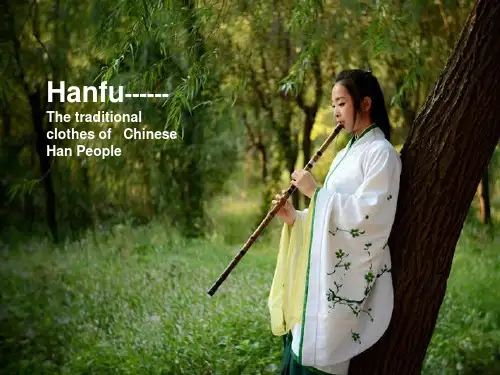
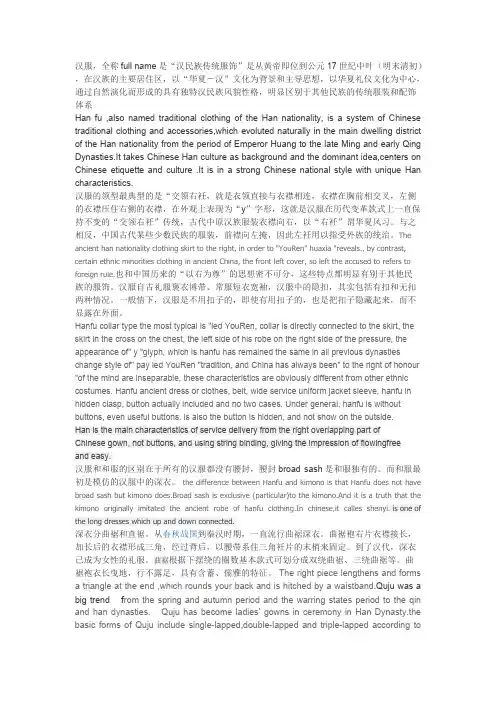
汉服,全称full name是“汉民族传统服饰”是从黄帝即位到公元17世纪中叶(明末清初),在汉族的主要居住区,以“华夏-汉”文化为背景和主导思想,以华夏礼仪文化为中心,通过自然演化而形成的具有独特汉民族风貌性格,明显区别于其他民族的传统服装和配饰体系Han fu ,also named traditional clothing of the Han nationality, is a system of Chinese traditional clothing and accessories,which evoluted naturally in the main dwelling district of the Han nationality from the period of Emperor Huang to the late Ming and early Qing Dynasties.It takes Chinese Han culture as background and the dominant idea,centers on Chinese etiquette and culture .It is in a strong Chinese national style with unique Han characteristics.汉服的领型最典型的是“交领右衽,就是衣领直接与衣襟相连,衣襟在胸前相交叉,左侧的衣襟压住右侧的衣襟,在外观上表现为“y”字形,这就是汉服在历代变革款式上一直保持不变的“交领右衽”传统,古代中原汉族服装衣襟向右,以“右衽”谓华夏风习。
与之相反,中国古代某些少数民族的服装,前襟向左掩,因此左衽用以指受外族的统治。
The ancient han nationality clothing skirt to the right, in order to "YouRen" huaxia "reveals., by contrast, certain ethnic minorities clothing in ancient China, the front left cover, so left the accused to refers to foreign rule.也和中国历来的“以右为尊”的思想密不可分,这些特点都明显有别于其他民族的服饰。
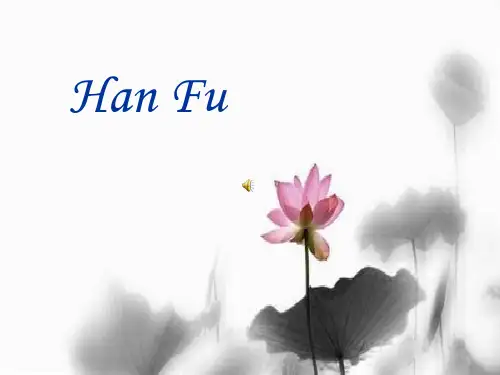
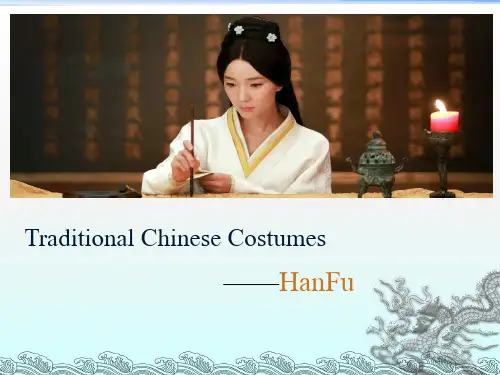
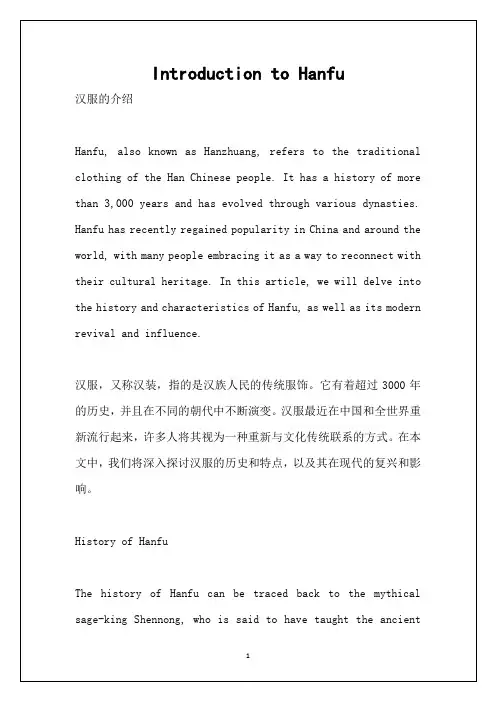
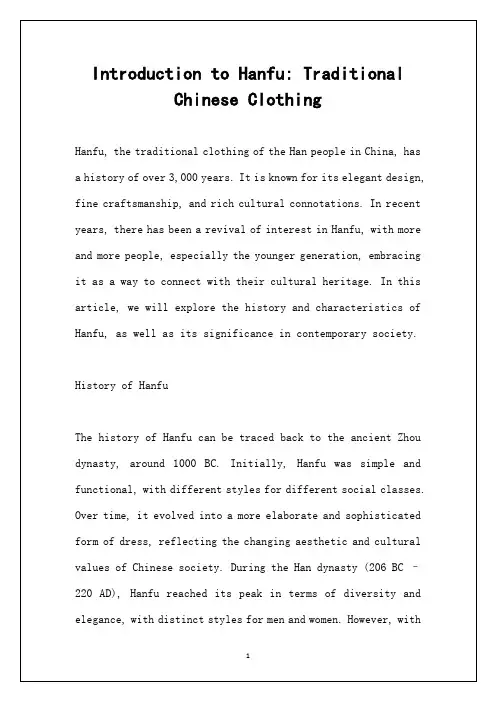
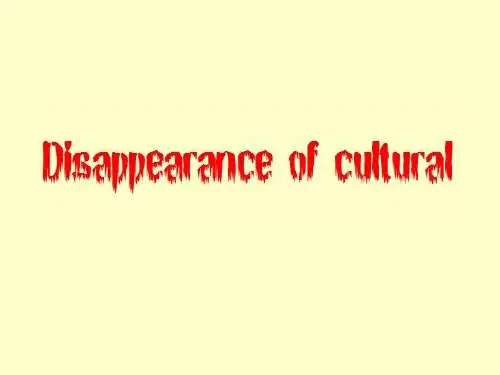
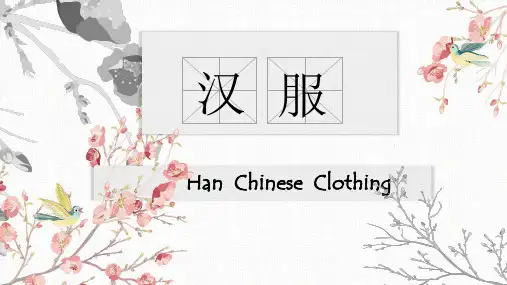

汉服中英文对照汉族Han ethnic group襦裙ru skirt曲裾curving-front robe袄裙coat skirt褙子sleeved over-dress半臂half-arm shawl襦裙简介:Ru skirt belongs to a kind of hanfu, wear a short coat in the upside ang a skirt in the downside. The top coat usually shorter than knee. It is the typical “top coat-plus-skirt” of clothing system. (襦裙是汉服的一种,上身穿的短衣和下身束的裙子合称襦裙,是典型的“上衣下裳”衣制。
上衣叫做“襦”,长度较短,一般长不过膝,下身则叫“裙”。
可见,“襦裙”其实是两种衣物的合称。
包括对襟襦裙和交领襦裙两类。
)曲裾简介:Curving-front robe is simpler to distinguish than other type of hanfu. It’s edge spiral down. Spiral down till the end is the Quju, not down to the end is a short Quju. (曲裾相对于其他汉服很好分辨,曲裾的边缘螺旋而下,螺旋到底的是曲裾,不到底的是短曲裾。
) 袄裙简介:Coat skirt is the dress that is out side the skirt. “ao”, a jacket with a lining. (袄裙是指上衣在裙子之外的女装。
袄,是有衬里的上衣。
)褙子:1.Both sides from the armpit not sutured(两侧从腋下起不缝合。
)2.Ofen worn outside the other clothes(多罩在其他衣服外面穿。
汉服中英文翻译简介汉服中英文翻译简介汉服,即汉民族传统服饰,,正式名称为华夏衣冠,古又称汉装、华服、汉衣冠等。
汉服起源于华夏文明肇始的炎黄时代,定型于春秋战国,汉民族在汉朝正式形成后遂有汉服之名。
此后,历朝历代均有沿革,但其基本特点从未改变。
汉服大体上可分为周汉汉服、魏晋南北朝汉服、隋唐汉服、宋明汉服四个发展阶段,周汉风格古朴凝重,魏晋风格潇洒飘逸,隋唐风格雍容华贵, 宋明两朝为汉服的集大成时代, 古朴、典雅、华贵、明快等多种风格并存,百花齐放,形成了蔚为大观的汉服体系。
(满清入关后,汉服在满清政府“削发易服”的民族压迫政策下被人为禁止。
此后,代表中国文化的正统华夏衣冠――汉服,从中华大地基本消失。
)汉服的主要特点是交领右衽、隐扣束带、宽袍大袖,不用扣子,而用绳带系结,给人洒脱飘逸的印象,这些特点都明显有别于其他民族的服饰。
汉服有礼服和常服之分,礼服制式严谨,为正式场合穿的服饰;常服一般去掉大袖,适合百姓日常起居。
以衣冠(汉服)、礼仪(汉礼)为表征的中国,被邻国评为衣冠之国、礼仪之邦。
汉服运动是旨在以复兴汉民族传统服饰为媒介,引导人们增强对传统文化的关注和思考,寻回失落的华夏情节,由物质的汉服导向精神的文明,并最终实现传统中华文化向现代转型的社会文化复兴运动。
“中国有服章之美谓之华,有礼仪之大谓之夏”,与华夏衣冠(汉服)相应的礼不是形式,而是民族历史之积淀,民族之根脉,汉服之美更须礼仪之大的依托。
礼的卑己尊人、长幼有序、严密规范诠释着华夏社会的理想,而庄重、纯正、质朴的周礼更充分的发挥了礼的内涵。
汉服属广义的礼的范畴,通过礼仪的形式,指向华夏文明的内涵,因此汉服是礼与仁的统一。
Han served, that is, the traditional costume of the Han nationality, formally known as the Chinese dressed, also known as the ancient Chinese equipment, and services to China and Chinese dressed, and so on.第一张图。
上街碰到老外,怎么介绍汉服?不知道大家有没有留意到,最近能碰到一些穿汉服或者对汉服感兴趣的歪果仁,其实这也是一件令人高兴的事,毕竟歪果仁也开始在复兴咱们中国的传统服饰文化。
为了弘扬咱汉服的美,除了穿得美美哒,你还必须会用英语介绍呀!但是如何和他们进行简单交流呢?现在就来学学如何用英语聊汉服!汉服的英文是——汉服(Hanfu),即汉民族传统服饰(the traditional dress ofthe Han Chinese people),又称汉衣冠、汉装(Hanzhuang)、华服(Huafu)。
汉服主要是指明末清初以前,汉族(及汉族的先民)以民族文化为基础,形成的具有民族特点的服装饰体系,即明末清初以前汉族所着的、具有浓郁汉族民族风格的一系列民族服饰的总体集合。
汉服象征着辉煌灿烂的华夏文明,并且深刻影响了整个东亚地区,和服(Japanese kimono)、韩服(Korean hanbok)都是从汉服演变过去的。
外国人一般把中国传统服饰笼统称为Chinese silk robe,我们也可以将其翻译成Han costume或者Han Chinese clothing,也可以采用拼音翻译直接说成hanfu。
同样属于中国传统服饰的“唐装”英文为Tang suit,“旗袍”为cheongsam。
汉服基本结构分为上装(upper garment)、下装(lower garment)、衽(lapel)、裾(hem)、袖(sleeve)、带(sash)等部分。
相配套的头饰包括男用的巾:male cap for the common people;冠:male cap for the honored and privileged;官员戴的幞头、乌纱帽、方巾等一系列headwear for officials;女用的笄、钗和男用的束发簪等hairpiece。
汉服的主要特点是交领、右衽,不用扣子,而用绳带系结,给人以中国洒脱飘逸的印象。
汉族Han ethnic group
襦裙ru skirt
曲裾curving-front robe
袄裙coat skirt
褙子sleeved over-dress
半臂half-arm shawl
襦裙简介:Ru skirt belongs to a kind of hanfu, wear a short coat in the upside ang a skirt in the downside. The top coat usually shorter than knee. It is the typical “top coat-plus-skirt” of clothing system. (襦裙是汉服的一种,上身穿的短衣和下身束的裙子合称襦裙,是典型的“上衣下裳”衣制。
上衣叫做“襦”,长度较短,一般长不过膝,下身则叫“裙”。
可见,“襦裙”其实是两种衣物的合称。
包括对襟襦裙和交领襦裙两类。
)
曲裾简介:Curving-front robe is simpler to distinguish than other type of hanfu. It’s edge spiral down. Spiral down till the end is the Quju, not down to the end is a short Quju. (曲裾相对于其他汉服很好分辨,曲裾的边缘螺旋而下,螺旋到底的是曲裾,不到底的是短曲裾。
) 袄裙简介:Coat skirt is the dress that is out side the skirt. “ao”, a jacket with a lining. (袄裙是指上衣在裙子之外的女装。
袄,是有衬里的上衣。
)
褙子:1.Both sides from the armpit not sutured(两侧从腋下起不缝合。
)
2.Ofen worn outside the other clothes(多罩在其他衣服外面穿。
)
半臂:As the name suggests, half arm is half sleeve. (顾名思义,半臂就是半袖。
)。